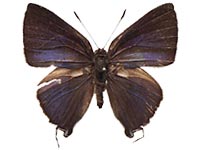
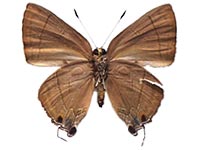
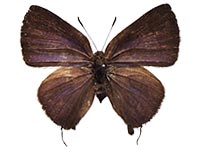

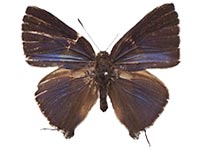
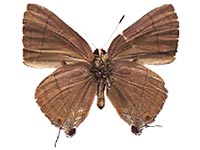


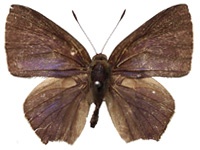

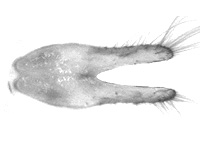
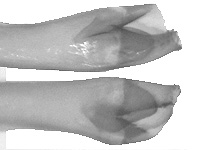
 |
 |
 |
 |
| ♂, Chiang Mai, Thailand. | ♀, Chiang Mai, Thailand. | ||
 |
 |
 |
 |
| ♂, Chiang Mai, Thailand. | ♀, Chiang Mai, Thailand. | ||
 |
 |
 |
 |
| ♂, Chiang Mai, Thailand. | ♂ genitalia, Chiang Mai, Thailand. | ||
| ON :
Rapala rosacea Nicéville, 1889 OD : J. asiat. Soc. Bengal, Part II. 57(4): 285, pl.14, fig.12,♂. TL : Sikkim. Distribution : Nepal, Sikkim, Assam, N.Thailand, Laos, Vietnam. |
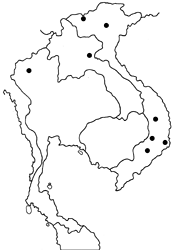 |
'Rapala nissa ranta var. bifida Cantlie, 1959 : J. Bombay nat. Hist. Soc. 56(3): 652-653. Loc. Sadon, N. Burma. (IFS)'
Rapala hinomaru Fujioka, 1970 ; Spec. Bull. Lepid. Soc. Japan (4): 29-30, pl.11, figs.5(HT,♀), 6(HT,♀Un). TL. Darapani (1000m)-The Tombol Bridge, Nepal. (CUBM)
hinomaru ; Holotype ♀, 25.vi.1963, Darapani (1000m)-The Tombol Bridge, East Nepal. T.Fujioka leg. (CUBM) ; Sajan et al.,2025 : 45-46, figs.9, ♀,♀(Un).
[ THAILAND ]
Rapala rectivitta ; Pinratana,1981 : pl.28, fig.16,♂(Un). (in part)
Rapala rosacea ; Ek-Amnuay,[2007] : 716, pl.327, figs.L423,♂,♂(Un). (Chiang Mai: Doi Suthep)
Rapala rosacea ; Ek-Amnuay,2012 : 764, pl.351, figs.L444,♂,♂(Un),♀,♀(Un). (Chiang Mai: Doi Suthep)
Rapala rosacea ; Kimura et al.,2014 : 142, figs.♂,♂(Un),♂,♂(Un),♀,♀(Un). (Doi Suthep)
[ LAOS ]
Rapala rosacea ; Miyamoto & Nakamura,2016 : 26-27, figs.20A♂,B♂(Un),C♀,D♀(Un). (Xieng Khouang)
Rapala rosacea ; Onodera,2022 : 97, pl.231, figs.♂,♂(Un). (Xiengkhouang: Tha)
[ VIETNAM ]
Rapala rosacea ; Miyazaki, Saito & Saito,2006d : 68, fig.L-145,♂. (Lam Dong: Dambri)
Rapala rosacea ; Yokochi et al.,2015 : 42. (Khanh Hoa: Hon Ba)
Rapala rosacea ; Monastyrskii & Devyatkin,2015 : 69. (C: Gia Lai)
[ THAILAND ]
Chiang Mai : 7♂ 2♀ (2♂ genitalia dissected).
| Jan | Feb | Mar | Apr | May | Jun | Jul | Aug | Sep | Oct | Nov | Dec |
| Jan | Feb | Mar | Apr | May | Jun | Jul | Aug | Sep | Oct | Nov | Dec |
| Jan | Feb | Mar | Apr | May | Jun | Jul | Aug | Sep | Oct | Nov | Dec |
| Jan | Feb | Mar | Apr | May | Jun | Jul | Aug | Sep | Oct | Nov | Dec |
| Jan | Feb | Mar | Apr | May | Jun | Jul | Aug | Sep | Oct | Nov | Dec |
This is a rather localized species, but is not rare in its habitats.
The butterfly is found in montane forests at moderate to high elevations (Alt. 1300 - 1600m).
Sajan et al. (2025) synonymised Rapala hinomaru with Rapala nissa.
However, based on the following reasons, I consider it more likely that hinomaru is a female of rosacea rather than nissa.
1) The upperside of both wings is mostly lacking in steel blue scales, whereas nissa never lacks steel blue scales.
2) The wing shape is rounded (especially the hindwing), differing entirely from nissa which is elongated longitudinally.
3) The striae in space 1a on the UnH are significantly broad, whereas it does not become markedly broad in nissa.
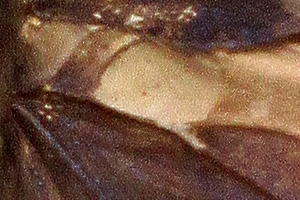 |
|
| Rapala rosacea UpH, androconial patch |
Nicéville, L. de,1889 : On new or little-known Butterflies from the Indian Region.
J. asiat. Soc. Bengal, Part II. 57(4): 273-293, pls.13,14.
Leech, J.H.,1890 : New species of Lepidoptera from China.
Entomologist 23: 26-50, 81-83, : 109-114, : 187-192, pl. 1.
Cantlie, K.,1959 : A new variety of the butterfly Rapala nissa ranta Swinhoe.
J. Bombay nat. Hist. Soc. 56(3): 652-653.
Fujioka, T.,1970 : Butterflies collected by the Lepidopterological Research Expedition to Nepal Himalaya, 1963. Part 1 Papilionoidea.
Spec. Bull. Lepid. Soc. Japan (4): 1-125.
Huang, H.,2001 : Report of H. Huang's 2000 Expedition to SE. Tibet for Rhopalocera.
Neue ent. Nachr. 51: 65-152.
Sajan, KC., Van der Poel, P., Pariyar, S., Sunar, A. & Singhlimbu, M.,2025 :
A review of the genus Rapala Moore, 1881 (Lepidoptera: Lycaenidae: Theclinae) of Nepal with insights on little-known species.
Zootaxa 5692(1): 031-056.
|
1999.07.21 - 2025.10.31.
|